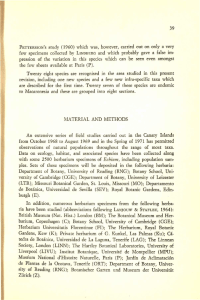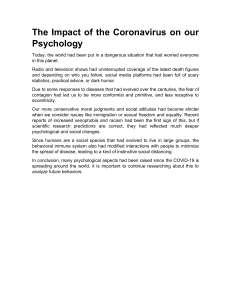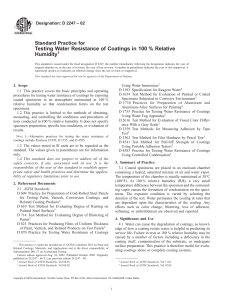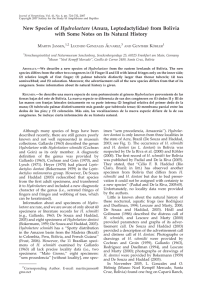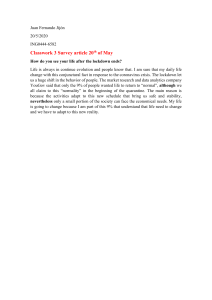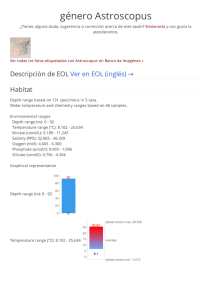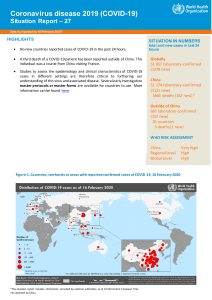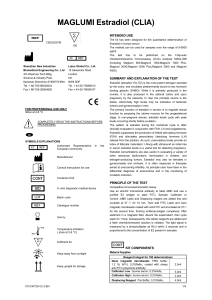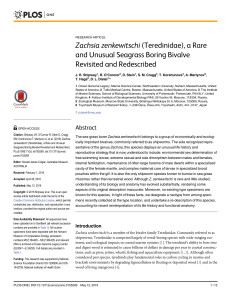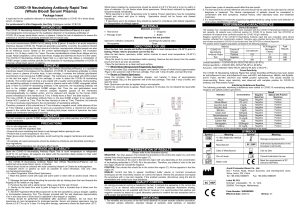ACFrOgAopebWOVOIe0-7Pd-N8D0T5nr-dLsFA2iQ EQfyqG59cOw2b8SyefwyTvktZ-2gkkihyZofgydTbrOg1tEVMXW8AnVGOJtU6-GMRCAEM2BRox69Ehlu6hjvMMDaP2OYXKKb-lIIe0RTNBO
Anuncio
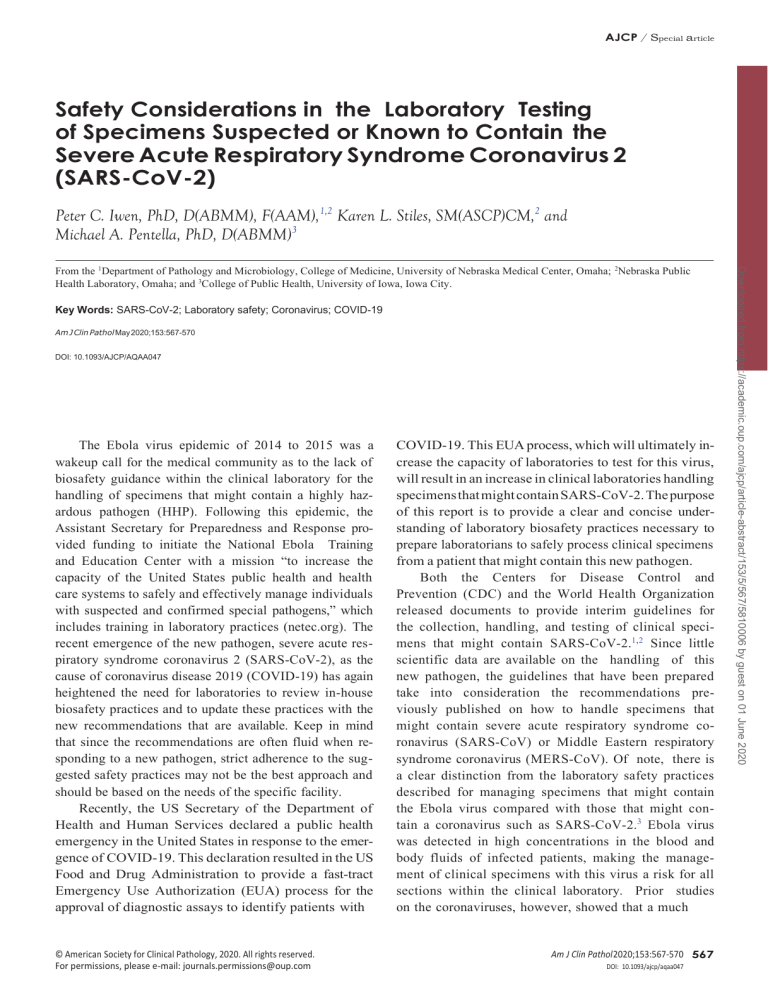
AJCP / Special article Safety Considerations in the Laboratory Testing of Specimens Suspected or Known to Contain the Severe Acute Respiratory Syndrome Coronavirus 2 (SARS-CoV-2) Peter C. Iwen, PhD, D(ABMM), F(AAM),1,2 Karen L. Stiles, SM(ASCP)CM,2 and Michael A. Pentella, PhD, D(ABMM)3 Key Words: SARS-CoV-2; Laboratory safety; Coronavirus; COVID-19 Am J Clin Pathol May 2020;153:567-570 DOI: 10.1093/AJCP/AQAA047 The Ebola virus epidemic of 2014 to 2015 was a wakeup call for the medical community as to the lack of biosafety guidance within the clinical laboratory for the handling of specimens that might contain a highly hazardous pathogen (HHP). Following this epidemic, the Assistant Secretary for Preparedness and Response provided funding to initiate the National Ebola Training and Education Center with a mission “to increase the capacity of the United States public health and health care systems to safely and effectively manage individuals with suspected and confirmed special pathogens,” which includes training in laboratory practices (netec.org). The recent emergence of the new pathogen, severe acute respiratory syndrome coronavirus 2 (SARS-CoV-2), as the cause of coronavirus disease 2019 (COVID-19) has again heightened the need for laboratories to review in-house biosafety practices and to update these practices with the new recommendations that are available. Keep in mind that since the recommendations are often fluid when responding to a new pathogen, strict adherence to the suggested safety practices may not be the best approach and should be based on the needs of the specific facility. Recently, the US Secretary of the Department of Health and Human Services declared a public health emergency in the United States in response to the emergence of COVID-19. This declaration resulted in the US Food and Drug Administration to provide a fast-tract Emergency Use Authorization (EUA) process for the approval of diagnostic assays to identify patients with © American Society for Clinical Pathology, 2020. All rights reserved. For permissions, please e-mail: journals.permissions@oup.com COVID-19. This EUA process, which will ultimately increase the capacity of laboratories to test for this virus, will result in an increase in clinical laboratories handling specimens that might contain SARS-CoV-2. The purpose of this report is to provide a clear and concise understanding of laboratory biosafety practices necessary to prepare laboratorians to safely process clinical specimens from a patient that might contain this new pathogen. Both the Centers for Disease Control and Prevention (CDC) and the World Health Organization released documents to provide interim guidelines for the collection, handling, and testing of clinical specimens that might contain SARS-CoV-2.1,2 Since little scientific data are available on the handling of this new pathogen, the guidelines that have been prepared take into consideration the recommendations previously published on how to handle specimens that might contain severe acute respiratory syndrome coronavirus (SARS-CoV) or Middle Eastern respiratory syndrome coronavirus (MERS-CoV). Of note, there is a clear distinction from the laboratory safety practices described for managing specimens that might contain the Ebola virus compared with those that might contain a coronavirus such as SARS-CoV-2.3 Ebola virus was detected in high concentrations in the blood and body fluids of infected patients, making the management of clinical specimens with this virus a risk for all sections within the clinical laboratory. Prior studies on the coronaviruses, however, showed that a much Am J Clin Pathol 2020;153:567-570 567 DOI: 10.1093/ajcp/aqaa047 Downloaded from https://academic.oup.com/ajcp/article-abstract/153/5/567/5810006 by guest on 01 June 2020 From the 1Department of Pathology and Microbiology, College of Medicine, University of Nebraska Medical Center, Omaha; 2Nebraska Public Health Laboratory, Omaha; and 3College of Public Health, University of Iowa, Iowa City. Iwen et al / S afety C onSiderationS in teSting S peCimenS C ontaining SarS-C oV-2 568 Am J Clin Pathol 2020;153:567-570 DOI: 10.1093/ajcp/aqaa047 examination and processing of formalin-fixed or otherwise inactivated tissues, molecular analysis of extracted nucleic acid preparations, electron microscopic studies with glutaraldehyde-fixed grids, routine examination of bacterial and mycotic cultures, routine staining and microscopic analysis of fixed smears, final packaging of specimens for transport, and inactivation of specimens such as the placing of specimens in a nucleic acid extraction buffer.1 The CDC guidance further suggests that some of the standard practices used in the laboratory during the manipulation of potentially infected specimens be, at a minimum, performed in a certified class II BSC within the BSL-2 laboratory. These included aliquoting and/or diluting specimens, inoculating bacterial or mycological culture media, performing diagnostic tests that do not involve propagation of viral agents in vitro or in vivo, nucleic acid extraction procedures involving potentially infected specimens, and preparation of chemical or heat fixing of smears for microscopic analysis. For virus isolation in cell culture and initial characterization of viral agents recovered in cultures of SAR2-CoV specimens, the CDC also suggests that this work be performed in a BSL-3 laboratory while using BSL-3 practices (to include fit-tested N95 respirators or powered air-purifying respirators). In general, while working within the laboratory environment, regulatory standards require that all health care facilities provide the appropriate personal protective equipment (PPE) for the laboratorians, that personnel be instructed in the proper use of this PPE, that the equipment being used in the laboratory be maintained and safe, and that written procedures for the procurement, transportation, and handling of patient specimens be available. As a standard for any laboratory biosafety program, it is also important to realize that the first step to consider is to identify hazards by performing a biological risk assessment. In general, the risk assessment consists of characterizing the risks, having a strategy for mitigating the risks, and providing an adequately trained workforce to safely perform the tasks as assigned in the laboratory ❚Table 1❚. As a part of this process, each laboratory should conduct a facility-specific risk assessment that reviews the procedures performed, identifies the hazards involved in the processes and procedures, determines the competency level of the personnel who perform the procedures, and evaluates the equipment and facility design. Once mitigation strategies are addressed, personnel are properly trained, and the necessary equipment and laboratory practices are defined, the process is complete. As a part of this, ❚Table 2❚ defines some of the other core processes that need to be in place to support laboratory biosafety practices when handling a specimen from a patient under investigation for COVID-19. © American Society for Clinical Pathology Downloaded from https://academic.oup.com/ajcp/article-abstract/153/5/567/5810006 by guest on 01 June 2020 lower concentration of the virus was noted in the nonrespiratory specimens, such as stool, urine, and blood, and that these specimens did not pose a major risk to the laboratorian while using standard bloodborne pathogen biosafety level (BSL)–2 precautions.4,5 Recently a study by Wang et al6 also showed that low titer SARS-CoV-2 RNA was present in 29% of fecal specimens and 1% of blood specimens and that none of the urine specimens had detectable viral RNA from patients infected with COVID-19. This study did not address the viability of the virus. History also suggested that laboratory-acquired infections (LAIs) while working with specimens containing MERS-CoV and SARS-CoV were rare, and in the few cases in which an LAI did occur while working in research laboratories, clear breaks in biosafety practices were noted. Aerial transmission is considered the major exposure risk to the coronaviruses such as SARS-CoV-2. However, current information is still not available to define specifically the infectious dose for this new pathogen. With this previous information on the coronaviruses, the processing of respiratory specimens, which generally takes place in the microbiology laboratory, would be considered to pose the highest risk to the laboratorian. Other laboratory sections, such as hematology, chemistry, and blood banking, where nonrespiratory specimens such as blood products and urine that potentially could contain a low concentration of the virus are processed, generally lack access to equipment such as a centrifuge with sealed rotors/safety cups or to a certified biological safety cabinet (BSC). Although it is recognized that these laboratory sections do follow BSL-2 blood-borne pathogen standards, additional practices might be considered following a risk assessment to prevent exposures to aerosols and droplets when processing specimens that might contain SARSCoV-2. Overall, manipulation of respiratory specimens that might contain this new pathogen should be done in a BSL-2 laboratory with enhanced practices, where appropriate (certified BSC, appropriate physical containment devices such as a centrifuge with safety buckets or sealed rotors, eye and face protection, double gloves, and fit-tested N95 respirator or surgical mask if N95 respirator is not available). The risk group classification of SARS-CoV-2 has not been officially designated at the time of this writing. The consensus, however, is to classify SARS-CoV-19 as a risk group 3 pathogen, similar to SARS-CoV and MERSCoV. With this classification, the interim guidance from the CDC suggests that the following practices may be performed in the standard BSL-2 laboratory when handling a specimen that might contain SARS-CoV-2: pathologic AJCP / Special article ❚Table 1❚ Simplified Biological Risk Assessment Focus Processes PPE, personal protective equipment. From the standpoint of the histopathology laboratory, the processing of frozen sections from a possible case of COVID-19 should be performed only in a cryostat where aerosols can be contained while wearing the appropriate PPE.7 Any SARS-CoV-2 in specimens that have been formalin fixed and paraffin embedded, however, should be inactivated based on the previous information reported for the inactivation of SARS-CoV. In conclusion, the emergence of a new pathogen presents a number of challenges and concerns about the unknown characteristics of the pathogen. Laboratorians are aware that any specimen received in the laboratory may contain a pathogen capable of containing an HHP and that the laboratory administration is required to provide a safe environment for the staff where quality laboratory testing can be performed. This balance of safety and providing a quality result is a delicate process and requires administration support and leadership. The important message is that not all laboratories are alike, and through a risk assessment, managers can put into place a process necessary to be able to provide a safe environment for the staff. © American Society for Clinical Pathology Topic Processes to Consider Training Proper collection of specimens Donning and doffing of PPEb Packaging and shipping of category B specimensc Strategies for waste managementd Centrifuge with sealed rotor or safety cupse Certified BSCe Use of a point-of-care device outside the BSCe Adequate supply of specimen collection devices Appropriate disinfection materialsf Adequate transport materials (for on-site and off-site transport) Open lines with the medical care team Collaborations in place with the state/local public health laboratory Equipment Inventory control Communication BSC, biological safety cabinet; PPE, personal protective equipment. a All procedures in the laboratory are performed based on a risk assessment. Personnel handling any specimen in the laboratory use standard precautions at biosafety level 2. b In situations in which aerosols and droplets are produced and respiratory protection such as fit testing for an N95 respirator are not available, a physical barrier such as a splash shield while using a surgical mask may be considered. c Personnel are trained in the proper safety, packaging, and shipping regulations for UN3373 Biological Substances, Category B when transporting specimens from a person under investigation for coronavirus disease 2019 (COVID-19). d Follow standard procedures used in the laboratory for disposal of specimens that might contain other respiratory pathogens such as the seasonal influenza virus. e When a certified BSC is not available and there is a potential for general aerosols or droplets, or if instruments such as a centrifuge with safety cups or sealed rotors or a point-of-care device cannot be used inside a BSC, use extra precaution to provide a barrier between the specimen and personnel such as a mask or respirator plus other physical barriers such as a splash shield and other appropriate PPE. f Use an Environmental Protection Agency–registered hospital disinfectant with label claims effective against respiratory viral pathogens while following the manufacturer’s recommendations for use. Corresponding author: Peter C. Iwen, PhD, D(ABMM), F(AAM); piwen@unmc.edu. References 1. Centers for Disease Control and Prevention (CDC). Interim laboratory biosafety guidelines for handling and processing specimens associated with coronavirus disease 2019 (COVID-19). https://www.cdc.gov/coronavirus/2019-nCoV/lab/lab-biosafetyguidelines.html. Accessed March 7, 2020. 2. World Health Organization. Laboratory biosafety guidance related to the novel coronavirus (2019-nCoV): interim guidance. https://www.who.int/docs/default-source/coronaviruse/ laboratory-biosafety-novel-coronavirus-version-1-1. pdf?sfvrsn=912a9847_2. Accessed March 7, 2020. Am J Clin Pathol 2020;153:567-570 569 DOI: 10.1093/ajcp/aqaa047 Downloaded from https://academic.oup.com/ajcp/article-abstract/153/5/567/5810006 by guest on 01 June 2020 Risk Identify hazards characterization Classify the potential for exposure (mode of transmission, organism concentration, virulence, potential for spill or inhalation) Identify activities that may increase the risk of exposure (instruments to be used and exposure potential) Evaluate and prioritize risks and then develop a mitigation strategy (determine likelihood and consequence of a specific risk) Risk mitigation Identify required safety practices to address strategies the risks (PPE, engineering controls, training, operating procedures) Determine whether additional risk mitigation strategies are needed (upgrades of equipment, facility changes, implementation of new training programs) Provide communication to staff on risks and mitigation (includes record-keeping) Validation of risk mitigation strategies (review assessment and mitigation strategies after implementation to ensure measures are effective) Workforce Identify personnel affected through workflow in the laboratory Assess competency and experience of laboratory personnel Identify an appropriate training program Enroll staff in an occupational health program ❚Table 2❚ Basic Core Processes to Support Laboratory Biosafety Practices When Handling Specimens From a Patient Under Investigation for COVID-19a Iwen et al / S afety C onSiderationS in teSting S peCimenS C ontaining SarS-C oV-2 3. Cheng PK, Wong DA, Tong LK, et al. Viral shedding patterns of coronavirus in patients with probable severe acute respiratory syndrome. Lancet. 2004;363:1699-1700. 4. Chang L, Ying Y, Wang L. Coronavirus disease 2019: coronaviruses and blood safety [published online February 21, 2020]. Trans Med Rev. 5. Iwen PC, Smith PW, Hewlett AL, et al. Safety considerations in the laboratory testing of specimens suspected or known to contain Ebola virus. Am J Clin Pathol. 2015;143:4-5. 6. Wang W, Zu Y, Gao R, et al. Detection of SARS-CoV-2 in different types of clinical specimens [published online March 11, 2020]. JAMA. doi:10.1001/jama.2020.3786. 7. Henwood AF. Coronavirus disinfection in histopathology [published online March 1, 2020]. J Histotech. doi:10.1080/014 78885.2020.1734718. Downloaded from https://academic.oup.com/ajcp/article-abstract/153/5/567/5810006 by guest on 01 June 2020 570 Am J Clin Pathol 2020;153:567-570 DOI: 10.1093/AJCP/AQAA047 © American Society for Clinical Pathology

